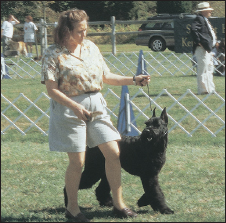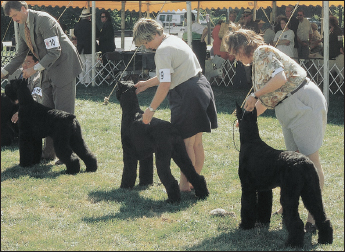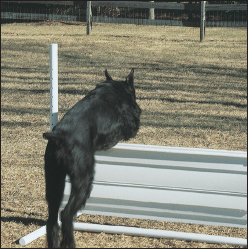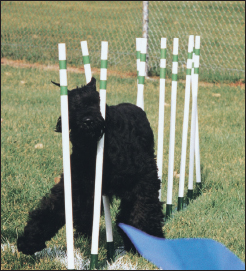

Is dog showing in your blood? Are you excited by the idea of gaiting your handsome Giant Schnauzer around the ring to the thunderous applause of an enthusiastic audience? Are you certain that your beloved Giant Schnauzer is flawless? You are not alone! Every loving owner thinks that his dog has no faults, or too few to mention. No matter how many times an owner reads the breed standard, he cannot find any faults in his aristocratic companion dog. If this sounds like you, and if you are considering entering your Giant Schnauzer in a dog show, here are some basic questions to ask yourself:
• Did you purchase a “show-quality” puppy from the breeder?
• Is your puppy at least six months of age?
• Does the puppy exhibit correct show type for his breed?
• Does your puppy have any disqualifying faults?
• Is your Giant Schnauzer registered with the American Kennel Club?
• How much time do you have to devote to training, grooming, conditioning and exhibiting your dog?
• Do you understand the rules and regulations of a dog show?
• Do you have time to learn how to show your dog properly?
• Do you have the financial resources to invest in showing your dog?
• Will you show the dog yourself or hire a professional handler?
• Do you have a vehicle that can accommodate your weekend trips to the dog shows?
Success in the show ring requires more than a pretty face, a waggy tail and a pocketful of liver. Even though dog shows can be exciting and enjoyable, the sport of conformation makes great demands on the exhibitors and the dogs. Winning exhibitors live for their dogs, devoting time and money to their dogs’ presentation, conditioning and training. Very few novices, even those with good dogs, will find themselves in the winners’ circle, though it does happen. Don’t be disheartened, though. Every exhibitor began as a novice and worked his way up to the Group ring. It’s the “working your way up” part that you must keep in mind.
Assuming that you have purchased a puppy of the correct type and quality for showing, let’s begin to examine the world of showing and what’s required to get started. Although the entry fee into a dog show is nominal, there are lots of other hidden costs involved with “finishing” your Giant Schnauzer, that is, making him a champion. Things like equipment, travel, training and conditioning all cost money. A more serious campaign will include fees for a professional handler, boarding, cross-country travel and advertising. Top-winning show dogs can represent a very considerable investment—over $100,000 has been spent in campaigning some dogs. (The investment can be less, of course, for owners who don’t use professional handlers.)
Many owners, on the other hand, enter their “average” Giant Schnauzers in dog shows for the fun and enjoyment of it. Dog showing makes an absorbing hobby, with many rewards for dogs and owners alike. If you’re having fun, meeting other people who share your interests and enjoying the overall experience, you likely will catch the “bug.” Once the dog-show bug bites, its effects can last a lifetime; it’s certainly much better than a deer tick! Soon you will be envisioning yourself in the center ring at the Westminster Kennel Club Dog Show in New York City, competing for the prestigious Best in Show cup. This magical dog show is televised annually from Madison Square Garden, and the victorious dog becomes a celebrity overnight.

AKC GROUPS
For showing purposes, the American Kennel Club divides its recognized breeds into seven groups: Working Dogs (of which the Giant Schnauzer is a member), Sporting Dogs, Hounds, Terriers, Toys, Non-Sporting Dogs and Herding Dogs.
AKC CONFORMATION SHOWING
GETTING STARTED
Visiting a dog show as a spectator is a great place to start. Pick up the show catalog to find out what time your breed is being shown, who is judging the breed and in which ring the classes will be held. To start, Giant Schnauzers compete against other Giant Schnauzers, and the winner is selected as Best of Breed by the judge. This is the procedure for each breed. At a group show, all of the Best of Breed winners go on to compete for Group One in their respective groups. For example, all Best of Breed winners in a given group compete against each other; this is done for all seven groups. Finally, all seven group winners go head to head in the ring for the Best in Show award.
What most spectators don’t understand is the basic idea of conformation. A dog show is often referred as a “conformation” show. This means that the judge should decide how each dog stacks up (conforms) to the breed standard for his given breed: how well does this Giant Schnauzer conform to the ideal representative detailed in the standard? Ideally, this is what happens. In reality, however, this ideal often gets slighted as the judge compares Giant Schnauzer #1 to Giant Schnauzer #2. Again, the ideal is that each dog is judged based on his merits in comparison to his breed standard, not in comparison to the other dogs in the ring. It is easier for judges to compare dogs of the same breed to decide which they think is the better specimen; in the Group and Best in Show ring, however, it is very difficult to compare one breed to another, like apples to oranges. Thus the dog’s conformation to the breed standard—not to mention advertising dollars and good handling—is essential to success in conformation shows. The dog described in the standard (the standard for each AKC breed is written and approved by the breed’s national parent club and then submitted to the AKC for approval) is the perfect dog of that breed, and breeders keep their eye on the standard when they choose which dogs to breed, hoping to get closer and closer to the ideal with each litter.
Another good first step for the novice is to join a dog club. You will be astonished by the many and different kinds of dog clubs in the country, with about 5,000 clubs holding events every year. Most clubs require that prospective new members present two letters of recommendation from existing members. Perhaps you’ve made some friends visiting a show held by a particular club and you would like to join that club. Dog clubs may specialize in a single breed, like a local or regional Giant Schnauzer club, or in a specific pursuit, such as obedience or tracking. There are all-breed clubs for all dog enthusiasts; they sponsor special training days, seminars on topics like grooming or handling or lectures on breeding or canine genetics. There are also clubs that specialize in certain types of dogs, like working dogs, herding dogs, companion dogs, etc.
A parent club is the national organization, sanctioned by the AKC, which promotes and safeguards its breed in the country. The Giant Schnauzer Club of America was formed in 1962 and can be contacted on the Internet at www.giantschnauzerclubof-america.com. The parent club holds an annual national specialty show, usually in a different region of the country each year, in which many of the country’s top dogs, handlers and breeders gather to compete. Additionally, the club holds regional shows and events throughout the year. At a specialty show, only members of a single breed are invited to participate. There are also group specialties, in which all members of a group are invited. For more information about dog clubs in your area, contact the AKC at www.akc.org on the Internet or write them at their Raleigh, NC address.
HOW SHOWS ARE ORGANIZED
Three kinds of conformation shows are offered by the AKC. There is the all-breed show, in which all AKC-recognized breeds can compete; the specialty show, which is for one breed only and usually sponsored by the breed’s parent club and the group show, for all breeds in one of the AKC’s seven groups. The Giant Schnauzer competes in the Working Group.
For a dog to become an AKC champion of record, the dog must earn 15 points at shows. The points must be awarded by at least three different judges and must include two “majors” under different judges. A “major” is a three-, four- or five-point win, and the number of points per win is determined by the number of dogs competing in the show on that day. (Dogs that are absent or are excused are not counted.) The number of points that are awarded varies from breed to breed. More dogs are needed to attain a major in more popular breeds, and fewer dogs are needed in less popular breeds. Yearly, the AKC evaluates the number of dogs in competition in each division (there are 14 divisions in all, based on geography) and may or may not change the numbers of dogs required for each number of points. For example, a major in Division 2 (Delaware, New Jersey and Pennsylvania) recently required 17 dogs or 16 bitches for a three-point major, 29 dogs or 27 bitches for a four-point major and 51 dogs or 46 bitches for a five-point major. The Giant Schnauzer attracts numerically proportionate representation at all-breed shows.
ON THE MOVE
The truest test of a dog’s proper structure is his gait, the way the dog moves. The American Kennel Club defines gait as “the pattern of footsteps at various rates of speed, each pattern distinguished by a particular rhythm and footfall.” That the dog moves smoothly and effortlessly indicates to the judge that the dog’s structure is well made. From the four-beat gallop, the fastest of canine gaits, to the high-lifting hackney gait, each breed varies in its correct gait; not every breed is expected to move in the same way. Each breed standard defines the correct gait for its breed and often identifies movement faults, such as toeing in, side-winding, over-reaching or crossing over.


The handlers “stack” their dogs in the show pose for the judge’s review. The judge moves down the line of competitors, considering each one’s merits in comparison to the breed standard.
Only one dog and one bitch of each breed can win points at a given show. There are no “co-ed” classes except for champions of record. Dogs and bitches do not compete against each other until they are champions. Dogs that are not champions (referred to as “class dogs”) compete in one of five classes. The class in which a dog is entered depends on age and previous show wins. First there is the Puppy Class (sometimes divided further into classes for 6- to 9-month-olds and 9- to 12-month-olds); next is the Novice Class (for dogs that have no points toward their championship and whose only first-place wins have come in the Puppy Class or the Novice Class, the latter class limited to three first places); then there is the American-bred Class (for dogs bred in the US); the Bred-by-Exhibitor Class (for dogs handled by their breeders or by immediate family members of their breeders) and the Open Class (for any non-champions). Any dog may enter the Open class, regardless of age or win history, but to be competitive the dog should be older and have ring experience.
The judge at the show begins judging the male dogs in the Puppy Class(es) and proceeds through the other classes. The judge awards first through fourth place in each class. The first-place winners of each class then compete with one another in the Winners Class to determine Winners Dog. The judge then starts over with the bitches, beginning with the Puppy Class(es) and proceeding up to the Winners Class to award Winners Bitch, just as he did with the dogs. A Reserve Winners Dog and Reserve Winners Bitch are also selected; they could be awarded the points in the case of a disqualification.
The Winners Dog and Winners Bitch are the two that are awarded the points for their breed. They then go on to compete with any champions of record (often called “specials”) of their breed that are entered in the show. The champions may be dogs or bitches; in this class, all are shown together. The judge reviews the Winners Dog and Winners Bitch along with all of the champions to select the Best of Breed winner. The Best of Winners is selected between the Winners Dog and Winners Bitch; if one of these two is selected Best of Breed as well, he or she is automatically determined Best of Winners. Lastly, the judge selects Best of Opposite Sex to the Best of Breed winner. The Best of Breed winner then goes on to compete in the group competition.
DRESS THE PART
It’s a dog show, so don’t forget your “costume.” Even though the show is about the dog, you also must play your role well. You have been cast as the “dog handler” and you must smartly dress the part. Solid colors make a nice complement to the dog’s coat, but choose colors that contrast. You don’t want to be wearing a solid color that blends mostly or entirely with the major or only color of your dog. Whether the show is indoors or out, you still must dress properly. You want the judge to perceive you as being professional, so polish, polish, polish! And don’t forget to wear sensible shoes; remember, you have to gait around the ring with your dog.

The impressive silhouette of a winning Giant Schnauzer.
At a group or all-breed show, the Best of Breed winners from each breed are divided into their respective groups to compete against one another for Group One through Group Four. Group One (first place) is awarded to the dog that best lives up to the ideal for his breed as described in the standard. A group judge, therefore, must have a thorough working knowledge of many breed standards. After placements have been made in each group, the seven Group One winners (from the Working Group, Toy Group, Hound Group, etc.) compete against each other for the top honor, Best in Show.
There are different ways to find out about dog shows in your area. The American Kennel Club’s monthly magazine, the American Kennel Gazette, is accompanied by the Events Calendar; this magazine is available through subscription. You can also look on the AKC’s and your parent club’s websites for information and check the event listings in your local newspaper.
Your Giant Schnauzer must be six months of age or older and registered with the AKC in order to be entered in AKC-sanctioned shows in which there are classes for the Giant Schnauzer. Your Giant Schnauzer also must not possess any disqualifying faults and must be sexually intact. The reason for the latter is simple: dog shows are the proving grounds to determine which dogs and bitches are worthy of being bred. If they cannot be bred, that defeats the purpose! On that note, only dogs that have achieved championships, thus proving their excellent quality, should be bred. If you have spayed or neutered your dog, however, there are many AKC events other than conformation, such as obedience trials, agility trials and the Canine Good Citizen® program, in which you and your Giant Schnauzer can participate.

At higher levels of obedience competition, the dog must clear a jump as well as retrieve over a jump.
FOR MORE INFORMATION….
For reliable up-to-date information about registration, dog shows and other canine competitions, contact one of the national registries by mail or via the Internet.
American Kennel Club
5580 Centerview Dr., Raleigh, NC 27606-3390
www.akc.org
United Kennel Club
100 E. Kilgore Road, Kalamazoo, MI 49002
www.ukcdogs.com
Canadian Kennel Club
89 Skyway Ave., Suite 100, Etobicoke, Ontario
M9W 6R4 Canada
www.ckc.ca
The Kennel Club
1-5 Clarges St., Piccadilly, London W1Y 8AB, UK
www.the-kennel-club.org.uk
OBEDIENCE TRIALS
Mrs. Helen Whitehouse Walker, a Standard Poodle fancier, can be credited with introducing obedience trials to the United States. In the 1930s, she designed a series of exercises based on those of the Associated Sheep, Police, Army Dog Society of Great Britain. These exercises were intended to evaluate the working relationship between dog and owner. Since those early days of the sport in the US, obedience trials have grown more and more popular, and now more than 2,000 trials each year attract over 100,000 dogs and their owners. Any dog registered with the AKC, regardless of neutering or other disqualifications that would preclude entry in conformation competition, can participate in obedience trials.
There are three levels of difficulty in obedience competition. The first (and easiest) level is the Novice, in which dogs can earn the Companion Dog (CD) title. The intermediate level is the Open level, in which the Companion Dog Excellent (CDX) title is awarded. The advanced level is the Utility level, in which dogs compete for the Utility Dog (UD) title. Classes at each level are further divided into “A” and “B,” with “A” for beginners and “B” for those with more experience. In order to win a title at a given level, a dog must earn three “legs.” A “leg” is accomplished when a dog scores 170 or higher (200 is a perfect score). The scoring system gets a little trickier when you understand that a dog must score more than 50% of the points available for each exercise in order to actually earn the points. Available points for each exercise range between 20 and 40.
A dog must complete different exercises at each level of obedience. The Novice exercises are the easiest, with the Open and finally the Utility levels progressing in difficulty. Examples of Novice exercises are on- and off-lead heeling, a figure-8 pattern, performing a recall (or come), long sit, long down and standing for examination. In the Open level, the Novice-level exercises are required again, but this time without a leash and for longer durations. In addition, the dog must clear a broad jump, retrieve over a jump and drop on recall. In the Utility level, the exercises are quite difficult, including executing basic commands based on hand signals, following a complex heeling pattern, locating articles based on scent discrimination and completing jumps at the handler’s direction.

Agility competition is fast-paced and fun, with plenty of running, jumping and other tests of the dogs’ coordination.

TRACKING
Tracking tests are exciting ways to test your Giant Schnauzer’s instinctive scenting ability on a competitive level. All dogs have a nose, and all breeds are welcome in tracking tests. The first AKC-licensed tracking test took place in 1937 as part of the Utility level at an obedience trial, and thus competitive tracking was officially begun. The first title, Tracking Dog (TD), was offered in 1947, ten years after the first official tracking test. It was not until 1980 that the AKC added the title Tracking Dog Excellent (TDX), which was followed by the title Versatile Surface Tracking (VST) in 1995. Champion Tracker (CT) is awarded to a dog who has earned all three of those titles.
The TD level is the first and most basic level in tracking, progressing in difficulty to the TDX and then the VST. A dog must follow a track laid by a human 30 to 120 minutes prior in order to earn the TD title. The track is about 500 yards long and contains up to 5 directional changes. At the next level, the TDX, the dog must follow a 3- to 5-hour-old track over a course that is up to 1,000 yards long and has up to 7 directional changes. In the most difficult level, the VST, the track is up to 5 hours old and located in an urban setting.
Once he’s earned the UD title, a dog can go on to win the prestigious title of Utility Dog Excellent (UDX) by winning “legs” in ten shows. Additionally, Utility Dogs who win “legs” in Open B and Utility B earn points toward the lofty title of Obedience Trial Champion (OTCh.). Established in 1977 by the AKC, this title requires a dog to earn 100 points as well as three first places in a combination of Open B and Utility B classes under three different judges. The “brass ring” of obedience competition is the AKC’s National Obedience Invitational. This is an exclusive competition for only the cream of the obedience crop. In order to qualify for the invitational, a dog must be ranked in either the top 25 all-breeds in obedience or in the top three for his breed in obedience. The title at stake here is that of National Obedience Champion (NOC).
AGILITY TRIALS
Agility trials became sanctioned by the AKC in August 1994, when the first licensed agility trials were held. Since that time, agility certainly has grown in popularity by leaps and bounds, literally! The AKC allows all registered breeds (including Miscellaneous Class breeds) to participate, providing the dog is 12 months of age or older. Agility is designed so that the handler demonstrates how well the dog can work at his side. The handler directs his dog through, over, under and around an obstacle course that includes jumps, tires, the dog walk, weave poles, pipe tunnels, collapsed tunnels and more. While working his way through the course, the dog must keep one eye and ear on the handler and the rest of his body on the course. The handler runs along with the dog, giving verbal and hand signals to guide the dog through the course.
The first organization to promote agility trials in the US was the United States Dog Agility Association, Inc. (USDAA). Established in 1986, the USDAA sparked the formation of many member clubs around the country. To participate in USDAA trials, dogs must be at least 18 months of age.
The USDAA and AKC both offer titles to winning dogs, although the exercises and requirements of the two organizations differ. Agility Dog (AD), Advanced Agility Dog (AAD) and Master Agility Dog (MAD) are the titles offered by the USDAA, while the AKC offers Novice Agility (NA), Open Agility (OA), Agility Excellent (AX) and Master Agility Excellent (MX). Beyond these four AKC titles, dogs can win additional titles in “jumper” classes: Jumper with Weave Novice (NAJ), Open (OAJ) and Excellent (MXJ). The ultimate title in AKC agility is MACH, Master Agility Champion. Dogs can continue to add number designations to the MACH title, indicating how many times the dog has met the title’s requirements (MACH1, MACH2 and so on).

The agility weave poles, being navigated by a Giant Schnauzer.
Agility trials are a great way to keep your dog active, and they will keep you running, too! You should join a local agility club to learn more about the sport. These clubs offer sessions in which you can introduce your dog to the various obstacles as well as training classes to prepare him for competition. In no time, your dog will be climbing A-frames, crossing the dog walk and flying over hurdles, all with you right beside him. Your heart will leap every time your dog jumps through the hoop—and you’ll be having just as much (if not more) fun!